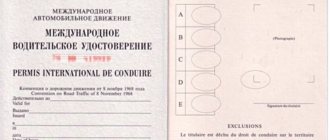Despite its long existence, what an exclamation mark on a car means, not all motorists still know, even those who can boast of impeccable experience and thorough knowledge of the rules of the road and all the badges affixed by its participants.
Lack of awareness manifests itself either in excessive caution (what if they are carrying something exploding?), or in the desire to quickly get ahead of a strange fellow traveler. I've heard the most incredible assumptions about what a sticker with an exclamation mark means.
What amused me the most was the creative idea that it warns that a blind person is driving. It would be more logical then to glue sunglasses to the rear window! True, there are few people who think so originally. The main decoding tendencies are “go around, otherwise you never know.” What the exclamation mark on the car means, meanwhile, one could guess if one were not too lazy to reason logically.
Why was it introduced and its meaning?
Since the first month of spring 2009, traffic rules have been enriched: now every motorist with no more than two years of experience is required to mark his car with a special sign. This rule appeared because very often it is novice drivers who are responsible for accidents. Due to lack of experience, they easily fall into the risk zone. And other motorists, seeing a car with a similar designation on the road, will try to drive the car as carefully as possible to prevent an accident.
How long to drive with a “novice driver” sign?
The legislation of the Russian Federation establishes a general period for all novice motorists - 2 years. This is the validity period of the sign for beginners. The driving record is kept from the moment the license is issued.
Some, having passed the mandatory adaptation period, continue to drive with a sticker on the rear window. The presence of a warning symbol guarantees them a calm attitude from other, more confident drivers. After two years, the person can decide for himself when to take it off.
More details about the rule
From paragraph 8 of the “Basic provisions for the admission of vehicles to operation” it follows: an identification sticker must be installed on vehicles driven by a driver with less than two years of experience. This is the “Beginner Driver”, which looks like a black exclamation mark on a bright yellow background. The height of such a square is 110 mm, and the width is 150. The sticker must be located on the rear side of the vehicle, not including self-propelled cars, motorcycles and tractors.
Can I be fined for missing a sign?
Know that the answer to this question is: no. Nowhere does it stipulate a monetary penalty for not having a sticker on your car. It is up to the driver to decide whether to use the sign or not. Of course, many traffic police officers still try to issue a fine if they don’t see the sticker on a newcomer’s car. However, such actions are absolutely groundless and illegal. Even if they point out to you a violation of administrative order, boldly stand your ground. The law is on your side in this case.
The meaning of the exclamation mark
The sticker has been around since 2009 and shows that the car is being driven by an inexperienced driver (as in: be careful!). By the way, less than 2 years of experience is considered a lack of experience. The officially recognized design is a black punctuation mark in a yellow square, although triangular stickers have also been seen. The following features are notable:
- There seems to be no requirement for beginners to stick a badge on glass. There are no fines for their absence; their presence is not stipulated by regulations. The presence of the sign on board is purely advisory;
- Moreover, if a new driver is stopped by a traffic police officer and notices that there is no sticker, he can point this out to the driver and strongly advise him to purchase one. And a person who has been driving for less than 2 years will not pass a technical inspection without the specified sticker.
It was assumed that such a sticker, firstly, would be applied by newcomers out of a sense of civic responsibility, and secondly, it would warn others that they should not always expect correct actions and mistakes in driving from a car with a sign.
Sticker expiration date
The sign can be removed after two years from the date of receipt of rights. However, if this period has passed, and you are still not confident in yourself, then the best solution would be to leave a sign. Likewise, you will be treated more carefully on the road, and there are no fines for having an “expired” sign. Many experienced drivers do not remove the exclamation mark from their car, considering it an excellent assistant on the track.
Sticker controversy
At one time, the introduction of such a badge caused heated debate in the automotive environment.
And we cannot say that they were so groundless. One of the disturbances was caused by the selected image. It is clear that the exclamation mark warns of increased danger.
However, which one exactly? What troubles can you expect from a car with a sticker? For example, the sticker-shoe, which has taken root, albeit unofficially, has become generally accepted because it clearly shows that the driver is a woman (or, according to another interpretation, a blonde). Here the signal is uninformative, so it is often missed by consciousness.
Experience is a rather relative concept.
. A person can get a license and not drive after 10 years. In this case, he is more dangerous than a driver who passed the test a year ago, but at the same time did not get out of the car all this time. However, he will not have any warning signs on board. So what's the point of putting stickers on those considered newbies?
As for the usefulness of the sticker for inexperienced drivers, opinions are divided. Some new drivers believe that the presence of a sticker on board has greatly simplified their life. Fellow travelers were more patient with low speed, uncertain maneuvering, and slow reactions. There were fewer nervous screams and signals from behind, and there was less aggression in cases of indecision in making a choice or taking action. And more experienced drivers maintained a greater distance, fearing an accidental rollback.
However, approximately the same number of newcomers encountered exactly the opposite reaction. They were deliberately cut off, overtaken at risk, blowing their horn at full fanfare at the slightest delay, and even colorfully describing their driving skills in pure Russian. According to people with such experience, the exclamation mark acts on some like a red rag on an already enraged bull. Many, after riding with it for a couple of months, removed the badge from the glass out of harm’s way.
In principle, if you understand what the exclamation mark on a car means, the idea should be considered sound and useful. The execution may have let us down, but the idea itself is good and correct. We can only regret that the culture of communication among some representatives of the driver tribe leaves much to be desired. And hope that the vast majority of drivers with experience will get into the situation, and will not complicate the acquisition of driving skills by beginners with stupid jokes and incorrect behavior on the road.
Yellow square details
A newcomer to the road must first of all think about his own safety and the safety of those around him. A sticker with an exclamation mark will only help you avoid tense situations and increase your self-confidence. Don’t be shy about this sign; on the road they will only show you special attention and caution: they won’t rush you or honk your horn intrusively.
It’s interesting that some people treat themselves with humor, namely, they put a teapot on a yellow background instead of an exclamation mark. Of course, it is commendable when a person admits that he is not yet a professional in the automotive business.
Red triangle sign on the road
A significant part of the modern population of the Earth owns some kind of transport. In developed countries, cars are especially common. Consequently, at some point there was an urgent need to create effective regulation of the increasingly intense road traffic. An international sign system was created. Currently, the entire variety of such symbols is divided into several main categories. Let's look at some of them.
Warning signs
This category is distinguished by the fact that a significant part of the designations is framed by a red triangle. In this way, they seem to focus the attention of the road user on a possible danger, which, in turn, is pointed out to them. Of course, the designation system includes the most common options for dangerous sections of the road. Movement along them requires maximum concentration and timely adoption of measures to stabilize the situation. For example, this could be an intersection with a railway, tram tracks, traffic control with traffic lights, dangerous turns, road surface features, permitted pedestrian movement, repair work, the possibility of animals appearing, and so on. If you see an exclamation mark in a red triangle, you should remember that such a designation includes the so-called “other hazards”. These are all kinds of threats to the further successful and stable movement that are not provided for by other symbols.
Priority signs
It should be remembered that not only in the previous category there is such a symbol as the red triangle. The sign is also included in the priority group. Here, a similar symbol also serves to attract the attention of the driver of the vehicle. A red triangle in the context of this category warns of the intersection of a main road with a secondary one, as well as the junction of the latter. It is important to remember that rapprochement can occur both on the right side and on the left. Let's look at another important question. What does an upside down red triangle mean? This symbol is called “Give way” and means that a traffic participant heading towards the intersection with the main road along a secondary road must take all necessary actions so as not to impede the movement of other drivers.
Features of the red triangle sign
Every road user should remember that the geometric figure described above is found only in the two groups presented earlier: warning and priority signs. In all others: prescriptive, prohibitive, informational, service, designations of additional information and special instructions - it is customary to use rectangles, squares and circles.
Location
As mentioned earlier, the red triangle is most often found in warning signs, the main purpose of which is to alert the driver to possible dangerous situations on the road. Consequently, the traffic rules describe the need to install it at a certain distance before the start of the suspicious area. Within a populated area, this value ranges from 50 to 100 meters, and outside it varies from 150 to 300 m. In some cases, additional installation of a special sign called “Distance to object” is provided, where the required value is displayed. In addition, if the dangerous area is quite long, it is also possible to install an “Area of Action” sign, which is installed under the corresponding warning symbol.
Important to remember
If any sign is located on a yellow background, this means that it is temporary. In relation to warning symbols, this may mean that the danger has arisen relatively recently, and road authorities have not yet had time to take measures to eliminate it. If you saw a red triangle on a yellow background and identified it as a priority sign, then it is likely that repair work is being carried out somewhere along your route. They were the reason for the change in movement on this section of the road. Of course, we should not forget that if there are regular and repair signs, it is imperative to comply with the requirements of the latter.
Release forms
Currently, all signs included in traffic regulations are made on a metal base, which is coated with a special reflective compound. This makes the sign visible at any time of the day. In some cases, LED contour lighting may be used. It is provided either by miniature incandescent lamps or the more common LEDs.
fb.ru>
In other countries
It’s not only in Russia that a newcomer stands out on the road. In the vast majority of countries, the “novice driver” sign is mandatory. If you don't stick it, you can get a significant fine. For example, in Lithuania our exclamation mark looks like a maple leaf on a white background. And in Italy there is a black letter “P” on an equally light square. By the way, in the boot-shaped country, for the first three years, newcomers to the road are prohibited from driving at speeds above 90 km/h in the city and beyond 100 km/h outside it.
Let's summarize:
- The “Beginner Driver” sign may not be used after obtaining a license. You will not receive a fine for this, but you will still have to stick a square when passing the technical inspection.
- In Russia and other countries, this sign only helps on the roads and reduces the likelihood of accidents. But there is also a difference: if in our country they are not fined for absence, then in Europe they will be asked to pay a substantial amount.
- A novice driver needs two years to get used to traffic and the road. That is why it is recommended to peel off the sign after this period has passed. However, if you are still not confident in yourself, then it is better to leave the square. This way you will drive much more carefully, and you will be treated more attentively on the highway.











